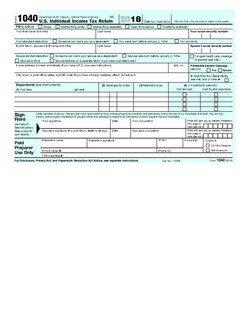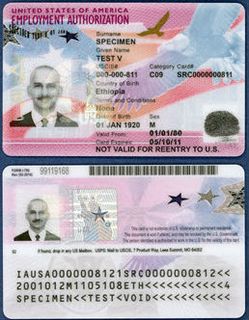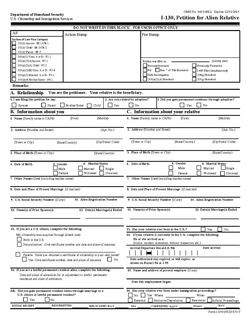Related Research Articles

Form 1040 an IRS tax form used for personal federal income tax returns filed by United States residents. The form calculates the total taxable income of the taxpayer and determines how much is to be paid or refunded by the government.

A green card, known officially as a Permanent Resident Card, is a document issued to immigrants under the Immigration and Nationality Act (INA) as evidence that the bearer has been granted the privilege of residing permanently in the United States. Individuals with green cards are known as Lawful Permanent Residents (LPR) or green card holders. There are an estimated 13.2 million green card holders of whom 8.9 million are eligible for citizenship of the United States. Approximately 65,000 of them serve in the U.S. Armed Forces.

The United States nationality law refers to the uniform rule of naturalization of the United States set out in the Immigration and Nationality Act of 1952, enacted under the power of Article 1, section 8, clause 4 of the United States Constitution, which grants the Congress the power to "establish a uniform Rule of Naturalization..." The 1952 Act sets forth the legal requirements for the acquisition of, and divestiture from, American nationality. The requirements have become more explicit since the ratification of the Fourteenth Amendment to the Constitution, with the most recent changes to the law having been made by Congress in 2001.
TN status or TN visa is a special non-immigrant classification in the United States that offers expedited work authorization to a citizen of Canada or a national of Mexico, created as a result of provisions of the North American Free Trade Agreement that mandate simplified entry and employment permission for certain professionals from each of the three NAFTA member states in the other member states.
U.S. Citizenship and Immigration Services (USCIS) is an agency of the United States Department of Homeland Security (DHS) that administers the country's naturalization and immigration system. It is a successor to the Immigration and Naturalization Service (INS), which was dissolved by the Homeland Security Act of 2002 and replaced by three components within the DHS: USCIS, Immigration and Customs Enforcement (ICE), and Customs and Border Protection (CBP).
The V visa is a temporary visa available to spouses and minor children of U.S. lawful permanent residents. It allows permanent residents to achieve family unity with their spouses and children while the immigration process takes its course. It was created by the Legal Immigration Family Equity Act of 2000. The Act is to relieve those who applied for immigrant visas on or before December 21, 2000. Practically, the V visa is currently not available to spouses and minor children of LPRs who have applied after December 21, 2000.
The term United States person or US person is used in various contexts in US laws and regulations with different meanings.
Permanent Residence Under Color of Law (PRUCOL) is not recognized as an immigration status by the U.S. Citizenship and Immigration Services (USCIS); this category was created by the courts and is a public benefits eligibility category. For a person to be residing "under color of law," the USCIS must know of the person’s presence in the U.S., and must provide the person with written assurance that enforcement of deportation is not planned. A person residing under PRUCOL status cannot directly apply for U.S. citizenship or sponsor family members to obtain U.S. Citizenship. A person from any country, who resides in the United States without current legal immigration status including, but not limited to, citizenship, permanent residency, unexpired immigrant visa, is an undocumented person. Though they are not U.S. citizens, they are considered to have the same rights as legal residents ‘for welfare eligibility purposes’.
An H-4 visa is a visa issued by the U.S. Citizenship and Immigration Services (USCIS) to immediate family members of the H-1B visa holders.

A Form I-766 employment authorization document or EAD card, known popularly as a work permit, is a document issued by the United States Citizenship and Immigration Services (USCIS) that provides temporary employment authorization to noncitizens in the United States.
Adjustment of status in the Immigration and Nationality Act (INA) of the United States refers to the legal process of conferring permanent residency upon any alien who is a refugee, asylum seeker, nonpermanent resident, conditional entrant, parolee, and so forth.
The Security Through Regularized Immigration and a Vibrant Economy Act of 2007 or STRIVE Act of 2007 is proposed United States legislation designed to address the problem of illegal immigration, introduced into the United States House of Representatives. Its supporters claim it would toughen border security, increase enforcement of and criminal penalties for illegal immigration, and establish an employment verification system to identify illegal aliens working in the United States. It would also establish new programs for both illegal aliens and new immigrant workers to achieve legal citizenship. Critics allege that the bill would turn law enforcement agencies into social welfare agencies as it would not allow CBP to detain illegal immigrants that are eligible for Z-visas and would grant amnesty to millions of illegal aliens with very few restrictions.
The Office of Immigration Statistics (OIS) is an agency of the United States Department of Homeland Security under the Office of Strategy, Policy, and Plans.
The Substantial Presence Test (SPT) is a criterion used by the Internal Revenue Service (IRS) in the United States to determine whether an individual who is not a citizen or lawful permanent resident in the recent past qualifies as a "resident for tax purposes" or a "nonresident for tax purposes"; it is a form of physical presence test. The SPT should be used in conjunction with the Green Card Test. An individual who satisfies either one or both of these tests is treated as a resident for tax purposes.

Form I-130, Petition for Alien Relative is a form submitted to the United States Citizenship and Immigration Services by a United States citizen or Lawful Permanent Resident petitioning for an immediate or close relative intending to immigrate to the United States. It is one of numerous USCIS immigration forms. As with all USCIS petitions, the person who submits the petition is called the petitioner and the relative on whose behalf the petition is made is called the beneficiary. The USCIS officer who evaluates the petition is called the adjudicator.
The National Visa Center (NVC) is a center that is part of the U.S. Department of State that plays the role of holding United States immigrant visa petitions approved by the United States Citizenship and Immigration Services until an immigrant visa number becomes available for the petition, at which point it arranges for the visa applicant(s) to take the visa interview at a consulate abroad. It is located in Portsmouth, New Hampshire. It was established in 1994 on the site of an Air Force base that was closed down by The Pentagon.
The Legal Immigration Family Equity Act of 2000, also known as the LIFE Act and as the Legal Immigration and Family Equity Act, along with its Amendments, made some changes to laws surrounding immigration for family members of United States citizens and Lawful Permanent Residents, as well as people eligible for employment-based immigrant visas, in the direction of making it easier for family members and immigrant workers to move to and adjust status within the United States. It was passed on December 21, 2000.
Special Immigrant Juvenile Status (SIJS) is a special way for minors currently in the United States to adjust status to that of Lawful Permanent Resident despite unauthorized entry or unlawful presence in the United States, that might usually make them inadmissible to the United States and create bars to Adjustment of Status. The key criterion for SIJS is abuse, neglect, or abandonment by one or both parents.

Form I-140, Immigrant Petition for Alien Worker is a form submitted to the United States Citizenship and Immigration Services (USCIS) by a prospective employer to petition an alien to work in the US on a permanent basis. This is done in the case when the worker is deemed extraordinary in some sense or when qualified workers do not exist in the US. The employer who files is called the petitioner, and the alien employee is called the beneficiary; these two can coincide in the case of a self-petitioner. The form is 6 pages long with a separate 10-page instructions document as of 2016. It is one of the USCIS immigration forms.

Systematic Alien Verification for Entitlements (SAVE) is a program managed by United States Citizenship and Immigration Services (USCIS), a branch of the U.S. Department of Homeland Security (DHS). SAVE facilitates lookups on the immigration and nationality status of individuals in the United States. It is an intergovernmental initiative designed to help federal, state, tribal, and local government agencies, or by a contractor acting on the agency's behalf, to determine eligibility for benefits, licenses or grants, government credentials, or to conduct background investigations. It is one of two programs that uses the Verification Information System (VIS). The other program is the Electronic Employment Eligibility Verification Program, also known as E-Verify, and is used by employers to verify the immigration status of employees. For additional verification, SAVE relies on the Person Centric Query System (PCQS).
References
- 1 2 "Alien Residency - Green Card Test". Internal Revenue Service. Retrieved January 4, 2016.
- 1 2 "The Green Card Test and the Substantial Presence Test". Internal Revenue Service. Retrieved January 4, 2016.
- ↑ "Resident Alien vs. Legal Permanent Resident". University of Richmond Controller's Office. Retrieved January 5, 2016.
- ↑ "Non-Resident Aliens (NRA) Frequently Asked Questions, Question 5 What is the "Green Card Test"?" . Retrieved January 5, 2016.